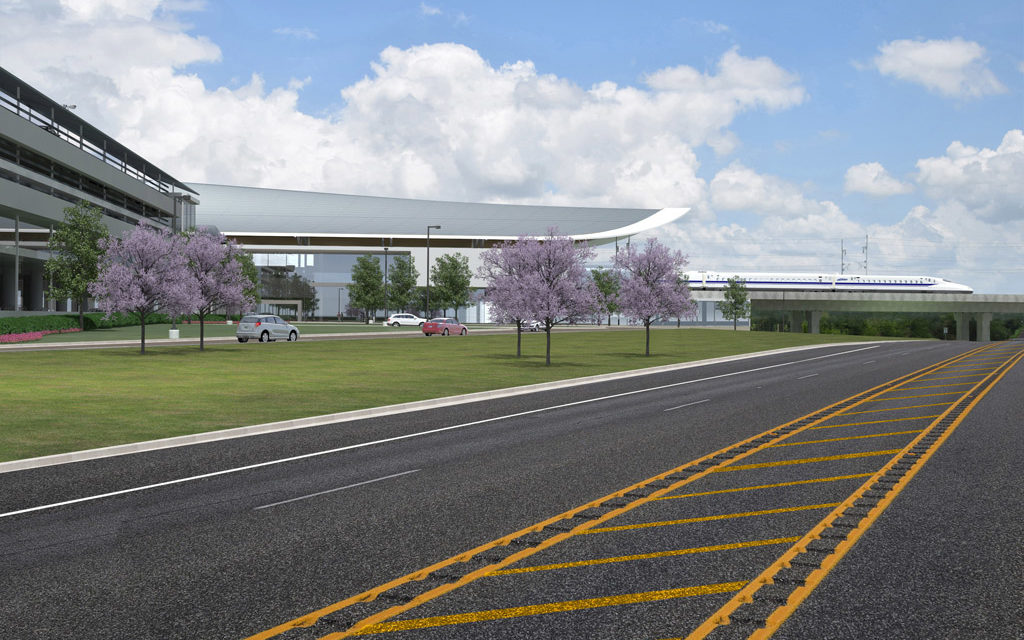Freestone County will play host to a public meeting on Wednesday, January 31, 2018 to review and submit comments on the Draft Environmental Impact Statement (EIS) in conjunction with the proposed High-Speed Rail project that would connect Dallas and Houston.
Included in the EIS will be simulated photos – the final designs are not complete – of the proposed midway station in Grimes County to the south of our area.
The Draft EIS, prepared by the Federal Railroad Administration (FRA), is a required environmental review, for projects of this size, which looks at potential impacts to the affected area and population.
The project has been closely watched by local landowners as the Utility Line route, favored by the Draft EIS, runs in our area through Navarro, Freestone, Leon, and Limestone counties.
Recently, new details were unveiled by TCR on the project’s passenger station in the Brazos Valley, by Texas Central Railway (TCR), the private entity behind the Texas Bullet Train project.
The Brazos Valley station will be built on 60 acres in the Roans Prairie area of Grimes County, located along Highway 30 and just west of Highway 90, about equidistant between College Station and Huntsville.
This station would be the only midway stop between Houston and Dallas. It is being designed to serve the areas of Bryan-College Station, Texas A&M, and Sam Houston State in Huntsville.
Plans call for a shuttle service that will directly link the Texas A&M University campus to the station as well as other nearby connections. From there, it will be a roughly 50-minute train ride to Dallas or a 30-minute ride to Houston.
Developers of the proposed project say that the Brazos Valley station will be a catalyst for economic development, new jobs and additional tax revenue for local counties and communities.
“You’re going to see investment from the commercial community, businesses, universities and other institutions because of the station,” says Brady Redwine, a vice president of Texas Central. “This really creates a super community of employees and employers, headquarters and educational institutions in a way we have never seen before.”
The terminal is being built on open land where company already has agreements with the current owner of the site.
All three stations, in Houston, Dallas and the Brazos Valley, are being designed to be environmentally friendly, minimizing energy and water usage and promote indoor air quality.
The public Meeting on Wednesday, January 31st will be held at Fairfield High School, from 5:00 to 9:00 p.m.
Before the public hearing presentation begins, an open house will be held to allow for comments, questions and review of project exhibits. FRA and TCR staff will be available to answer questions at that time.
The public hearing presentation will begin at 6 pm, followed by a public comment period.
Written comments on the Draft EIS for the Project should be provided to FRA on or before February 20, 2018. These written comments should be sent to Kevin Wright, Environmental Protection Specialist, FRA, at 1200 New Jersey Ave. SE, MS-20, Washington, D.C. 20590, through FRA’s website at https://www.fra.dot.gov/Page/P0700 or via email at kevin.wright@dot.gov or DallasHouston HSR@urs.com.
Comments may also be provided orally or in writing at the public hearings scheduled, including the public meeting in Freestone County, Texas on January 31st.
The role of this governmental agency in the process is to ensure that the High Speed Rail project is federally compliant, mitigates potential impacts, and is safe.
Perhaps the biggest contention of High-Speed Railway opponents is the potential acquirement of property through eminent domain.
Although publically stating their hope for voluntary property deals with effected landowners, Texas Central leaders have claimed the legal authority to condemn private property, if needed.
Many elected officials and landowners refute that claim, going as far as pushing for local ordinances to stop the project.






